 |
|
 |
|
 |
|
 |
 |
| Founders of the Grange |
|
On December 4, 1867 in a small Washington, D.C. building that housed the office of William Saunders, Superintendent of Propagating Gardens in the Department of Agriculture, the Order of Patrons of Husbandry (P of H), more commonly known as the Grange, was born. Here, sitting around a plain wooden table, a group of seven earnest men, planned what was destined to become a vital force in preserving and expanding American democracy. They were all men of vision-they had faith in God, in their fellow man and the future. The Seven Founders of the Order of the Patrons of Husbandry were:
Oliver H. Kelley
William Saunders
Aaron B. Grosh
William M. Ireland
John R. Thompson
Francis McDowell
John Trimble (Assisted by Caroline Hall) |
|
 |
 |
The names of the founders are inscribed on a Birthplace Marker located near the site of the original building on the south side of 4th Street SW, near Madison Street on the mall in Washington D.C. The marker was officially dedicated on September 9, 1951 and is the only private monument on the mall. |
|
|
|
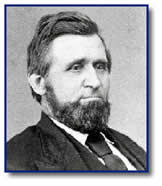
|
OLIVER HUDSON KELLEY
(1826 - 1913)
If it be true that a "dreamer" has been responsible for most of the progressive movements in human history, then it can truly be said that the dream of Oliver Hudson Kelley played a large part in the great farm fraternity that has so richly blessed the rural life of America under the name of Patrons of Husbandry - better known as the Grange.
Born a New England Yankee , Kelley was educated in the Boston public schools and at Chauncey Hall School. At 21 he went to Chicago where he worked in a drugstore and as a reporter for the Chicago Tribune.
|
 |
Mr. Kelley owned and operated the first reaping machine in Minnesota, and built the first frame barn in the state. He also had the distinction of being the first person initiated into the Masonic fraternity in Minnesota.
Mr. Kelley was an Episcopalian and in politics a Republican; but he was more of a humanitarian philosopher than either sectarian or a partisan.
His second marriage, the first being to Lucy Earle who died in 1851, to Miss Temperance Baldwin Lane resulted in the birth of four daughters, Julia, Frances, Grace and Garaphelia. Mrs. Kelley was the first Pomona in the National Grange.
After a crop failure in 1864, Mr. Kelley went to Washington, D.C. where he became a clerk in the Dept. of Agriculture, and the acquaintance there formed opened up the wider career which resulted in his selection by President Andrew Johnson to survey agricultural conditions in the Southern states following the Civil War.
He said that during his sojourn in the South he kept up a lively correspondence with many people in the North including his niece, Caroline A. Hall. He mentioned to Miss Hall that a secret society of agriculturalists might do a great deal to restore kindly feelings among the people of the North and South. At Mobile he received a reply from her that indicated she had great sympathy for the women of the South and encouraged him to give the idea profound consideration.
Kelley says, "On reaching Washington, April 21st, I made but a short stop, and spent the afternoon of the 22nd with Doctor Trimble. On leaving Washington, went first to Boston, where I gave Miss Hall my views of the association, in their crude state, to which she suggested that we give ladies full membership. This feature originated with her."
Mr. Kelley used his membership in the Masonic fraternity to open doors that would have been otherwise closed to a Northern Yankee during Reconstruction in the South and was able to establish the roots from which the National Grange would grow.
He was chosen the first secretary of the National Grange at its organization, December 4, 1867, serving until 1878. In 1871 the secretary's office was moved to Washington, followed by its removal to Louisville, Kentucky in 1875. At the 1877 session permission was given to locate the office at whatever point might be the choice of the incumbent; and following this vote Mr. Kelley moved his family to Florida, where he engaged in an extensive real estate development centering in the town of Carrabelle, named by him and named after Miss Caroline Hall, his niece and assistant in Grange work.
The Florida venture proved unprofitable and Mr. Kelley returned to Washington, where the closing years of his life were quietly spent, together with his wife and daughters. Particularly acceptable for family needs was a pension of one hundred dollars per month voted him by the National Grange at the session in 1905.
Mrs. Kelley's death occurred May 24, 1911, and Mr. Kelley died January 20, 1913. They were laid to rest in Rock Creek Cemetery in Washington. Thus, as the first of the Seven Founders in the inception of the Grange, Mr. Kelley was the last of them all to pass from earthly scenes. |
 |
(right) Oliver Hudson Kelley c. 1900.
Photo provided by O.H. Kelley himself to accompany a History of the Grange written by him for the Connecticut State Grange's first history book, "The Connecticut Granges," published by Industrial Publishing Co., 1900.
To Read the History of the Grange in Mr. Kelley's own words, click here. |
|
|
|
|
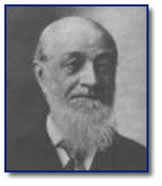
|
WILLIAM SAUNDERS
(1822 - 1900)
William Saunders was born at St. Andrews, Scotland on December 7, 1822, and his early education was based on the hope of his parents that he would enter the ministry. The fact that three generations of his paternal ancestors had been prominent gardeners appears to have been part of his inheritance and he was determined to follow in their footsteps. Accordingly, he left divinity school and became a journeyman to a famous gardener, followed by a course in horticulture at the College of Edinburgh. On Feb. 8, 1848, he married Miss Martha Mildwaters, and they immediately sailed for America.
|
 |
Mr. Saunders' first work as a gardener in America was on a private estate in New Haven, CT, and later he laid out Clinton Park near Baltimore, belonging to Johns Hopkins, founder of Maryland's great university. The results proved his skill and established his reputation, and he soon became recognized as an authority on horticulture, making extensive contributions to leading publications and becoming assistant editor of one of them. Expanding his activities, Mr. Saunders in 1854 formed a business partnership with Thomas Meehan at Germantown, PA, for landscaping, gardening and horticulture.
While in the nursery business, Mr. Saunders developed the idea of fixed glass roofs for greenhouses, which resulted in great savings to gardeners and florists. As his fame grew, calls for his service became more extended, and in 1862 he was appointed Superintendent of the Propagating Gardens in the Department of Agriculture, a position he held until the end of his life in 1900, a period of 38 years. With an office on the Capitol grounds (where the National Grange was organized) he began a career of plant development whose results have been far reaching.
When the National Cemetery at Gettysburg was proposed by the government, Mr. Saunders was called to the task of planning it, and at President Lincoln's request he spent an evening at the White House going over the entire proposed layout. The President heartily approved Mr. Saunder's recommendations, and early in October 1863, interments began, scarcely two months after the White House conference. On the day of the cemetery dedication, Nov. 19, 1863, he was one of those on the platform, and sat within a few feet of the President when the immortal Gettysburg address was delivered. Mr. Saunders received the formal thanks of the Commission in charge of the laying out of the cemetery and the personal thanks of President Lincoln, but he received no monetary payment of any kind for his great work.
This was perhaps Mr. Saunders' most notable landscaping achievement, although nearly as much can be said of his landscaping of the grounds on the western slope of the nation's Capitol, as well as those of Lincoln's Tomb and Monument at Springfield, Illinois. Other outstanding examples of his skill were Fairmount and Hunting Parks in Philadelphia, PA and the beautiful grounds of the Department of Agriculture in Washington, D.C.
Largely at his suggestion, also, was the plan of a broad avenue from the Capitol to the Potomac, with the Washington Monument at the Central Point- a clear vista 300 feet wide and beautifully adorned with flowers and shrubbery. This ambitious program, eventually carried out as he suggested, and later amplified by the erection of the Lincoln Memorial and other beautification projects in the center of the city.
Mr. Saunders introduced the seedless navel orange into the United States from Brazil. He had one of the very first magnolia trees in Washington, and it was he who prepared the plan for the Department of Agriculture Arboretum at the Paris Exhibition in 1889, for which he was awarded a gold medal by the Jury of Awards.
Brother Saunders served as National Master from December 1867 to January 1873, and for three more years was an esteemed member of the National Grange Executive Committee. He died on Sept. 11, 1900, at the age of 77 years, and is buried in Rock Creek Cemetery in Washington, D.C. Mrs. Saunders survived her husband 13 years and died in 1913. They had five children. |
|
|

|
JOHN R. THOMPSON
(1834 - 1894)
John Richardson Thompson was born in New Hampshire July 28, 1834, his boyhood and early manhood spent on farms in both New Hampshire and Vermont. At the beginning of the Civil War he enlisted at St. Johnsbury, Vermont, in Company K, 15th Vermont Volunteers, in what was called the "Eleven Months Men." He was made lieutenant in his company and promoted from time to time until he was finally transferred to the staff of General Stannard with the rank of colonel; and with his regiment he fought in the battle of Gettysburg.
|
 |
Soon after the close of the war he obtained a position in the Treasury Department at Washington and there became acquainted with Kelley and some of the other Founders. It is the general belief that he was the first one of the group with whom Kelley talked about his contemplated fraternity.
He became immediately interested and again Masonic training proved its value to Grange beginnings, as Mr. Thompson held high affiliation in that fraternity and was thoroughly versed in its rites and ceremonies. He was an enthusiastic ritualist, a brilliant writer and a talented originator. The Sixth and Seventh Degrees owe much of their charm to Mr. Thompson's able pen, while his revision and additions greatly improved the language of the lower degrees.
He was a very busy man, but so deep was his interest in the Grange that it is recorded he invariably carried with him a small tin box containing notes and memoranda regarding Grange plans, to which he added whatever thoughts came into his head during any moment of leisure he might happen to have.
The sixth degree was conferred in full form for the first time at the 17th annual session of the National Grange at Washington, D.C., in 1883; and upon his completion of the Seventh Degree ritual, as voted in 1887, the National Grange paid Mr. Thompson the sum of five hundred dollars as partial compensation for his work.
On December 7, 1867, the formal organization of the National Grange chose Mr. Thompson as Lecturer, and in 1872 he was elected treasurer to fill out the unexpired term of William M. Ireland, who had resigned. He was also High Priest of Demeter for nearly nine years.
Mr. Thompson was twice married. His first wife died in Vermont, leaving one daughter, his only child. Following the close of the Civil War, he married Miss Mary Herendun, a native of Canandaigua, New York, who died in 1881. She was greatly interested in the Order and was a member of the first Potomac Grange.
Mr. Thompson died on February 12, 1894, and was buried in Rock Creek Cemetery at Washington, D.C. |
|
|
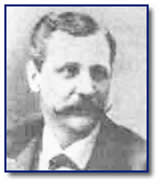
|
WILLIAM M. IRELAND
(? - 1891)
William M. Ireland was a Pennsylvanian by birth but spent a considerable part of his life in the nation's capital. For many years he held a responsible position as Chief Clerk of the Finance Office of the Post Office Department. Mr. Ireland was an enthusiastic member of the Masonic fraternity and upon meeting Oliver Hudson Kelley, J.R. Thompson and William Saunders, soon fell in with their idea of a similar fraternity for farmers. Mr. Ireland was a very intelligent person well skilled in fraternal organization and was an invaluable counselor in the formative period of the Order.
|
 |
Mr. Ireland was elected first Master of the National Grange but declined due to the fact that he was not directly connnected with agriculture, and Mr. Saunders was chosen. Mr. Ireland was then elected first Treasurer of the National Grange from which he resigned in 1872. He was a practical accountant and quite proficient in matters of finance. Mr. Ireland was also the first Master of Potomoc Grange (Washington, D.C.), which was set up chiefly as a practice Grange.
Upon the resignation of O.H. Kelley as National Secretary in 1878, Mr. Ireland was appointed to fill the vacancy. He was elected in 1879, and served until 1885. He resigned, effective April 15, 1885, to accept a position with General Albert Pike, who was the head of the Masonic Order in the United States. He never attended a National Grange session after 1885 and gradually drifted away from active membership.
Brother Ireland died on Christmas Eve, 1891, after a long and painful illness, and his burial was in Mt. Vernon Cemetery, Philadelphia. Mrs. Ireland was a member of Potomoc Grange but died shortly after its organization. |
|
|
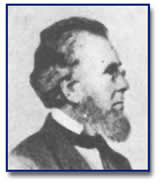
|
REV. AARON B. GROSH
(? - 1884)
Less of the life of Rev. Aaron B. Grosh is known than that of any of the other Founders, yet his part in building the Grange fraternity was by no means a minor one. He was a personal friend of William Saunders and later joined very heartily in Oliver Hudson Kelley's plans, while his part in the preparation of the ritual of the several degrees of the Order was highly important. Mr. Grosh was the first Chaplain of the National Grange and held that office for eight years, being one of the two officers reelected at the sixth annual session; the other being Secretary Kelley.
|
 |
Not only does the ritual of the first four degrees owe much of its beauty to the pen of Mr. Grosh, but he gathered together the first songs of the Grange, culling appropriate ones from various sources and later turning them over to Miss Caroline Hall, who added those of her own selection, obtained copyright permission, and published a songbook in her own name.
In his early youth Mr. Grosh worked on the farm and he was a country school teacher before entering the ministry. All his pastorates were also in rural environment, and he became greatly interested in everything pertaining to farm life and problems. After several years in the ministry, failing health and increasing age compelled a less strenuous life and a milder climate, consequently he accepted a clerkship offered him in the Department of Agriculture in Washington, D.C., soon after its establishment.
Mr. Grosh is best known in Grange circles for his exceedingly timely book, "Mentor in the Granges and Homes of Patrons of Husbandry," which according to its title page was "designed to explain the origin, aims and government of the Order, answering objectors, advise candidates, teach the lessons of each degree, and duties of officers and members; and thus aid Patrons to be better members of families, of the Order and of society"
Although this book was long ago out of print, it is still carefully preserved by some Grange leaders, and its timely advice and warnings - occasionally referred to in this volume - have served a purpose of great usefulness and inspiration.
Mr. Grosh was of Pennsylvania birth and of the Universalist faith. In addition to his Grange Mentor, he was the author of "The Odd Fellows Improved Manual," designed to serve a similar purpose for that fraternity. Mr. Grosh died March 27, 1884, and burial was in his native town of Marietta, Pennsylvania. Mrs. Grosh survived him, but, although a member of Potomac Grange, she apparently took little active part in Grange affairs, except by indirectly assisting her husband. The date of her death is not known. |
|
|

|
REV. JOHN TRIMBLE
(1831 - 1902)
John Trimble was born in New Jersey in 1831. He studied for the Ministry of the Protestant Episcopal Church and at some time during his active ministry received the degree of Doctor of Divinity. He was actively engaged in church work when the failure of his health compelled him to relinquish it and he turned in educational directions, being for several years the head of a large school in Kentucky. The latter was closed by the outbreak of the Civil War and Dr. Trimble returned his family to the North, subsequently making their home in Washington, D.C.
|
 |
For some time he filled the position of clerk in the Treasury Department in the division devoted to the settlement of war claims. Later he was named agent for the collection of war claims for several of the states.
After meeting O.H. Kelley and several of the other founders, Dr. Trimble became much interested in the Grange plan, and his value lay chiefly in the fact that he did not hesitate to point out what he considered errors in the various angles of the new fraternity. He was frequently referred to as the "Wet Blanket" of the organization, and as such he believed he could do more good than in any other way. Although his criticisms were oftentimes sharp, it appears that his associates valued his counsel highly and were usually guided by it.
For a long time, he refused to accept any office in the new organization, though proving one of its most valuable workers. After the election of Mr. Ireland as National Secretary, Dr. Trimble became his assistant, and at the 1884 session in Nashville, Tennessee, the absence of Mr. Ireland made it necessary for Dr. Trimble to report the entire proceedings, which he did ably and correctly.
When Mr. Ireland resigned in April 1885, Dr. Trimble was appointed to fill the vacancy and at the next meeting of the National Grange he was overwhelmingly elected Secretary, holding the position until his death which occurred on Dec. 30, 1902, after approximately 18 years of exceptional service. He was buried in Oak Hill Cemetery in Washington. He was the sixth of the founders to pass away, the only survivor at that time being Oliver Hudson Kelley.
Not only did Dr. Trimble's faithful service to the Order win the admiration of all his associates, but his fine Christian spirit did much to expand the fraternal Order of the Grange, and few Patrons ever have been held in higher esteem and affection. |
|
|
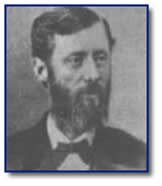
|
FRANCIS M. McDOWELL
(1831 - 1894)
Francis Marion McDowell was born at Wayne, New York in 1831, of British ancestry, his four grandparents being Scotch, English, Irish and Welsh respectively. In addition to the common schools at Wayne, he was educated at the institution which has since become Alfred University, in Alfred, New York, and for a time he taught school in his hometown.
Later he became partner in the banking and brokerage firm of Hallett & Company of NYC, and in this connection made frequent trips to Europe, especially to interest European capitalists in the construction of the Kansas Pacific Railway, of which his banking firm was a sponsor.
|
 |
In the early 1860s, Mr. McDowell had a severe illness, from which he never made complete recovery, consequently he returned to his native town of Wayne, New York, and engaged in grape growing on the shores of Lake Keuka. The grape industry was then in its infancy, but he lived to see it attain immense proportions.
It was at a fruit fair in Hammondsport, NY that he met William Saunders. The two men became friends at once and Mr. Saunders was a Sunday guest at Mr. McDowell's home. There they discussed the new Grange movement and Mr. McDowell was greatly interested. The following winter he went to Washington and became associated with the other six Founders.
Many of Mr. McDowell's ideas were embodied in the final setup and it was his belief that the organization should have a central division, to protect the work from being broken up and varying with different localities. It was therefore upon his suggestion that the Seventh Degree was built, and he was selected first High Priest in the Assembly of Demeter. In 1887 John R. Thompson, consulting with Mr. McDowell, wrote the ritual for the Seventh Degree.
As Treasurer of the National Grange for nearly twenty-one years, until failing health compelled his resignation in November 1893, Mr. McDowell's financial experience was invaluable; and he never missed attending a National Grange session from the beginning until the time of his death.
He was twice married, his first wife being Miss Josephine Spang of Philadelphia, whom he met and married while in London, and who died a few years later. In December 1874 he married Miss Eva Sherwood of Woodhull, New York, who shortly after joined the Grange, became deeply interested in its work and succeeded her husband as treasurer upon his resignation. They had one daughter.
More than once Mr. McDowell's eagerness to build into the new Order a sound financial system led him to advance his own private funds, and to make many sacrifices for the fulfillment of his financial ideals.
Mr. McDowell's death in March 1894, at Penn Yan, NY, followed shortly that of John R. Thompson. Interment was in Lake View Cemetery at Penn Yan. |
|
|
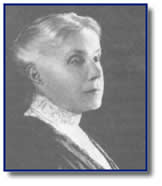
|
CAROLINE A. HALL
(1838 - 1918)
Caroline Arabella Hall should have been named among the Founders because of her great influence on the fundamental structure of the Order. It was she who insisted that, "Your organization will not succeed unless you give an equal place to women." Miss Hall was appointed to the position of Ceres of the National Grange by High Priest F.M. McDowell.
In a letter to Miss Hall under date of Nov. 16, 1868, Brother McDowell writes:
|
 |
"It having been made known to me as the Priest of Demeter in our most ancient and honorable Order, that you have taken a deep interest in our glorious work and were the first lady in this country to become familiar with our ritual, I do most cheerfully confer upon you as a reward for your faithful labors, the title of Ceres, which secures to you all the honors and benefits of the highest rank in our beloved institution. Let me assure you that this confers upon you, Most Worthy Sister, the most exalted position that can be attained by any Lady in our land." Thus Caroline A. Hall not only became the first Ceres of the National Grange, but also the first woman to hold any office in the Order.
She paid a visit to her hometown of Boston in 1868, and when she returned to Minnesota she made her home with the Kelley family. She became Brother Kelley's secretary and assistant and when Brother Kelley moved his family to Washington in 1871, she, of course, moved with them. She was a tireless worker and spent untold hours writing, writing and writing (longhand). She was capable, dedicated and willing.
After Brother Kelley resigned as Secretary of the National Grange in 1878 he moved to Florida where he was engaged for a time in the real estate business. Miss Hall again accompanied the family and continued to serve as Brother Kelley's personal secretary. The town of Carrabelle, Florida, was named in honor of Caroline Arabella Hall.
She eventually inherited a valuable farm from a brother, near Knapp, Wisconsin and lived there for many years. Failing health caused her to move to an apartment in Minneapolis. Here she was residing when she took an automobile trip in 1918. On Oct. 11, she was involved in an accident near French Lick, Indiana, from which she never recovered and on December 11, her death occurred at the age of 80 years. She is interred at Minneapolis in Lake Wood Cemetery. A friend said of her, "She just lived being sweet and lovely to everyone."
In 1915 at Oakland, California, the Assembly of Demeter voted unanimously to insert a page in the Sacred Record of the Order, recognizing Miss Hall as occupying the same position in the history of the Order of the Patrons of Husbandry as those previously named as the Founders of the Order.
|
|
|
 |
| |
 |
|
|
|
|
